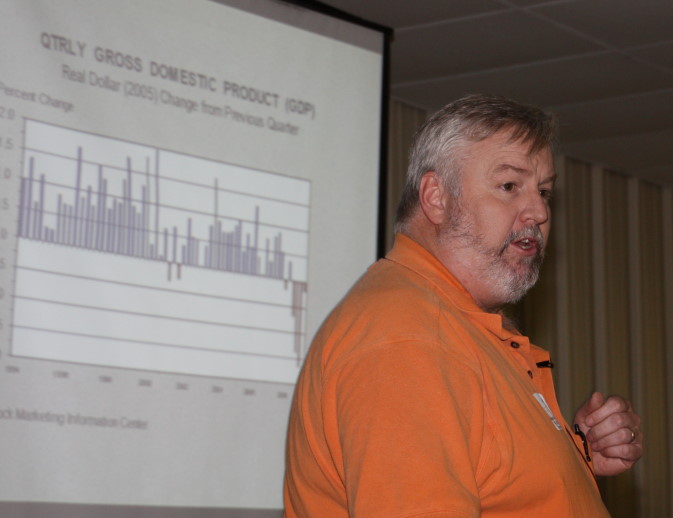
Agricultural News
We Have Got to Rebuild the US Cow Herd- So Says Derrell Peel of OSU
Mon, 29 Nov 2010 15:03:20 CST
 Dr. Derrell Peel, Extension Livestock Market Economist has several thoughts about where we stand in the cattle business as we near the end of 2010. Here are his latest comments in this first person commentary, courtesy of the weekly Cow Calf Corner that he and Dr. Glenn Selk co-produce.
Dr. Derrell Peel, Extension Livestock Market Economist has several thoughts about where we stand in the cattle business as we near the end of 2010. Here are his latest comments in this first person commentary, courtesy of the weekly Cow Calf Corner that he and Dr. Glenn Selk co-produce.
"A couple of weeks ago I wrote an article talking about the ability of the beef industry to continue current levels of beef production without rebuilding the herd. There are, of course, many factors that affect the situation and this article provides a bit more discussion of some of the many factors involved. It has been appropriately and correctly noted that some of the superlatives used by myself and others, such as the fact that the current beef cow herd is the smallest since 1963 are relevant only in a broad historical context.
"Many things have changed and the industry including the fact that the industry is much more efficient and cattle are bigger now, resulting in significantly more pounds of beef produced per cow. Thus, it is certainly the case that we do not need to return to any particular herd inventory level compared to history. However, the fact is that we cannot continue to increase or even maintain beef production if the cow herd continues to shrink. I suspect that carcass weights will show little or no upward trend in the next decade compared to the last twenty years. Thus much of the compensation for a declining inventory that was offset by increasing carcass weights in the past will not be available going forward.
"A more relevant time period is the last twenty years. The beef cow herd in 2010 was about one million head smaller at 31.4 million head than it was in 1990 (32.5 million head). In the intervening years the herd increased to a cyclical peak of 35.2 million head in 1996 to an apparent cyclical low of 32.9 million head in 2004 before the market shocks since 2007 pushed the herd down to current levels. Beef production in 2010 is projected at 26.03 billion pounds, 15 percent higher than in 1990 (which had a larger beef cow herd), about equal to the level in 1996 at the recent cyclical peak in cattle numbers and within 3 percent of the all time annual beef production record of 26.8 billion pounds in 2000.
"Beef and cattle trade plays a role in this as well. However, the relative importance of beef and cattle trade, in terms of overall production levels, has not changed much in the past twenty years. Net beef imports have accounted for roughly 4 percent of total beef production since 1990 and have, in fact, been smaller at roughly two percent of total annual production in the last three years. Net live cattle imports have averaged less than six percent of total slaughter since 1990 and will be slightly higher than that in 2010. While beef and cattle continue to grow in importance in terms of industry value, it does not explain our ability to maintain beef production in the face of declining U.S. cattle inventories.
"The fact is that we have culled an average of over 11 percent of the beef cow herd each of the past three years. Beef cow slaughter as a percent of the beef cow inventory has averaged 9.3 percent since 1990 and has only been higher than 11 percent once before since 1990, in 1996. Measured another way, beef cow slaughter has represented more than 10 percent of total cattle slaughter each of the past three years. Again, in the past twenty years, beef cow slaughter has averaged 9.2 percent of total slaughter and the only other time that beef cow slaughter was more than 10 percent of total cattle slaughter was in 1996. Another rough measure of slaughter intensity of the beef industry is that total slaughter will represent over 94 percent of the 2010 calf crop. This value has averaged 88.3 percent since 1990 and the estimate for 2010 is the highest level over the twenty year period.
"The bottom line is that it will not be possible to maintain beef production in coming years if we do not rebuild the cow herd and it is also true that we will not be able to rebuild the cow herd without reducing slaughter and beef production for at least a two to three year period. I believe that prices are approaching levels that will entice cow-calf producers into some level of herd expansion in the next couple of years. Smaller beef production will support higher beef and cattle prices. Consumers, who have for the most part not seen any impacts of this situation thus far, will experience higher beef prices in the coming years and this will provide a critical test of beef demand to see how consumers react to generally higher beef prices."
WebReadyTM Powered by WireReady® NSI
Top Agricultural News
More Headlines...



















